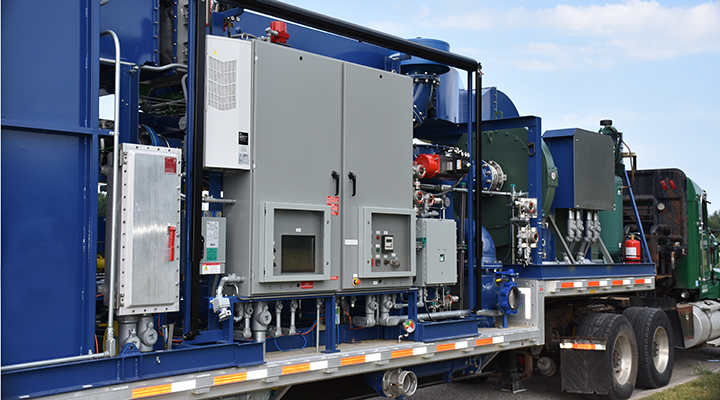Thermal Oxidizers
See All Mobile & Temporary ServicesMobile and emergency thermal oxidizing solutions to treat pipeline venting, storage tank venting and other vapor-related processes.
- is the minimum order quantity for this product. Please check quantity and add to cart again.

Mobile and emergency thermal oxidizing solutions to treat pipeline venting, storage tank venting and other vapor-related processes.
Description
Evoqua uses thermal oxidizers (TOs) to treat gases released during pipeline venting, aboveground storage tank (AST) venting, and other processes that release contaminated vapors.
Thermal Oxidizers (TO) Used in Aboveground Storage Tanks
Two common activities where a thermal oxidizer may be used are AST degassing and AST refilling. When product is removed from an AST, vapors remain inside. Degassing removes these vapors, so the AST is safe to enter for cleaning or maintenance.
Many ASTs have a roof that floats on the stored product. Any time there is vapor space under the floating roof, there is a risk for vapors to escape. During filling before the roof floats on the rising product, vapors are pushed up and out of the tank. Evoqua may use a thermal oxidizer to treat these vapors. Depending on the fill rate and product in the tank, Evoqua will use the right size TO.
Pipeline Degassing Using Thermal Oxidizers
Pipelines are another source of hazardous vapors. Pipeline degassing, cleaning, hydrotesting, decommissioning, and other activities may release contaminated gases. These must be captured and destroyed to protect human health and safety and the environment.
The vapor from such AST and pipeline activities is usually contaminated with hazardous air pollutants (HAPs) such as volatile organic compounds (VOCs), nitrogen oxides (NOx), and carbon monoxide (CO). Waste air must meet air discharge requirements before discharge to the atmosphere. TO units are used to meet these requirements.
Treatment Processes
Evoqua uses TO units and other technologies to destroy the contaminants in such gases. A thermal oxidizer (TO) removes various contaminants, especially hydrocarbons and volatile organic compounds (VOCs) from a waste air stream. When hydrocarbon-based pollutants are destroyed via thermal combustion they are chemically oxidized to form carbon dioxide (CO2) and water (H2O).
Thermal oxidizers control combustion conditions to ensure thorough destruction of the VOCs, CO, and volatile HAP emissions. Sufficient time, temperature, degree of mixing, and oxygen concentrations are needed for a complete combustion reaction. The temperature must be high enough to ignite the organic constituents in the waste gas stream. Residence time must be long enough for all the contaminants to thoroughly combust. Oxygen (O2) is required for combustion, and there must be enough O2 for all the hydrocarbons present to oxidize. Mixing ensures the O2 present contacts the hydrocarbon, so complete combustion can occur.
Residence time and mixing are fixed by oxidizer design. Temperature and O2 concentration are controlled during operation. The basic TO design is described in the following paragraphs.
The process blower pulls waste gas with hydrocarbon vapors from the source (tank, pipeline, etc.). The waste gas passes through a filter, a detonation arrestor, a moisture separator, and a primary flame arrestor. Our Coast Guard compliant TOs use a detonation arrestor for primary protection. The waste gas then enters the combustion chamber. In some TOs, the waste gas passes through a heat exchanger before entering the reaction chamber.
The combustion air blower provides air (which is about 21% O2) needed for the fuel gas burner in the reaction chamber. The hydrocarbons are destroyed and the treated air is discharged to the atmosphere.
Thermal oxidation requires the process gas vapors to be held at a hot enough temperature long enough for a complete reaction. Typically, an operating temperature of 1,400°F with a 1-second retention gives 99% destruction efficiency. Evoqua’s TO combustion chambers are designed and tested for a 1-second retention time at 1,500°F.
Evoqua’s TOs have influent LEL meters, an O2 detector, and an effluent PID, which send information to the programmable logic controller (PLC). The PLC controls certain valves in response to this information, to ensure safe, efficient, and effective treatment. The PLC also logs data, which is downloaded for the project summary.
When the VOC concentration is low, auxiliary fuel is added to maintain proper destruction temperatures. There are two main ways to reduce auxiliary fuel use. A recuperative TO has a heat exchanger that preheats the incoming gas with heat from the oxidizer exhaust. A catalytic TO uses a precious metal catalyst to reduce the oxidation temperature. The two processes can be combined, as in a recuperative catalytic TO.
Certain chemicals, halogenated and sulfonated compounds, are unable to be treated with standard thermal oxidization. This is due to the generation of acidic vapors during the oxidation process. To treat these groups of chemicals, Evoqua offers specialized TOs. Each of which consist of special lining to protect the unit from the acid vapors, followed by a caustic exhaust scrubber to remove the acid vapors before they are released.
Evoqua’s standard mobile TO is a direct-fired type with no heat recovery. Evoqua offers direct-fire TOs that range in size from 3M btu/hr up to 50M btu/hr. Evoqua has built catalytic TOs, recuperative TOs, and recuperative catalytic TOs. Evoqua decides which type to use depending on the specific needs of each job. Evoqua does not use regenerative or multi-chamber TOs since, for the types of jobs Evoqua does, these greatly increase project cost and provide minimal benefit.
Regular inspection and maintenance of the burner assemblies, blowers, fans, dampers, refractory lining, oxidizer shell, fuel lines, and ductwork ensures Evoqua TOs perform reliably. We use superior materials to ensure durability. Evoqua’s Engineering Department constantly seeks ways to make our TOs operate as efficiently as possible.
If you have a waste air stream requiring treatment, contact us today so we can get started on your project."
Features
Types of Remediation
- Aboveground Storage Tanks
- Barge Degassing
- Centrifuge Vapor Control
- Pipeline Degassing & Vapor Control
- Railcar Degassing & Vapor Control
- Underground Storage Tanks
- Vacuum & Tanker Truck Vapor Control
